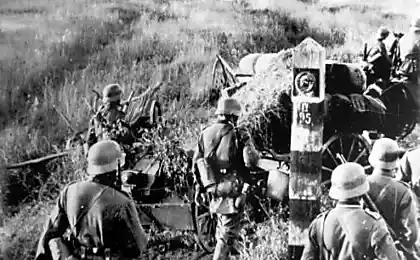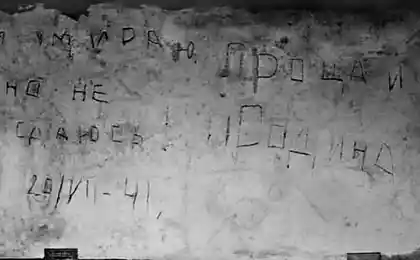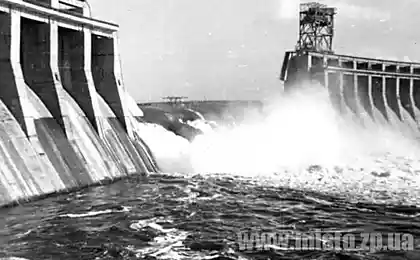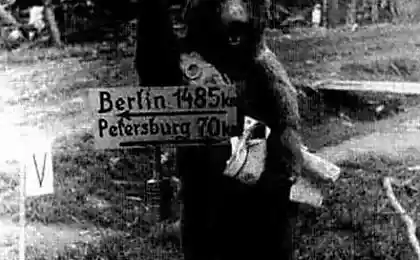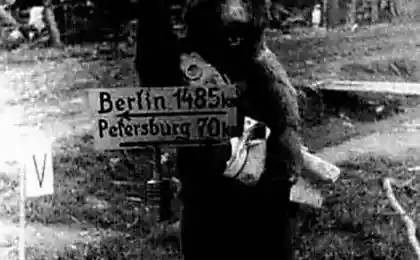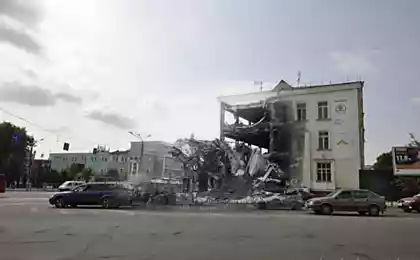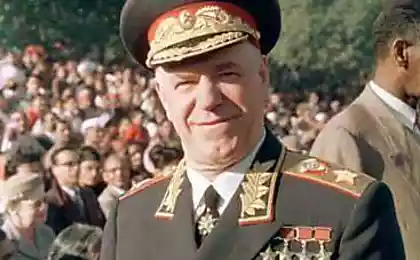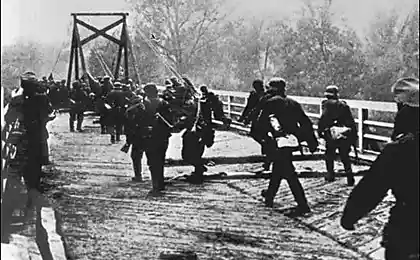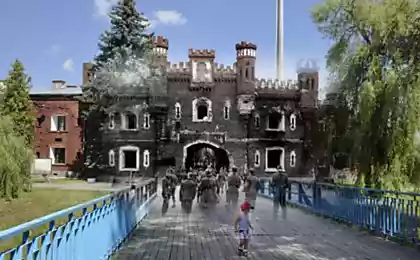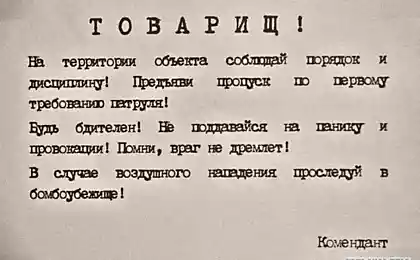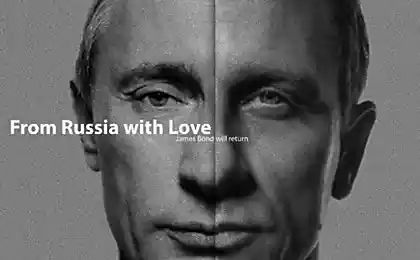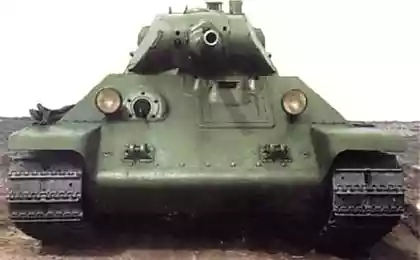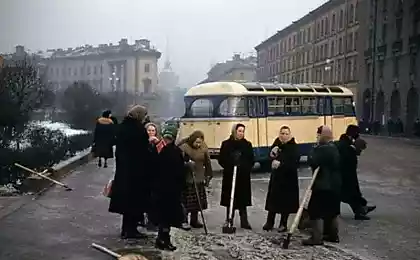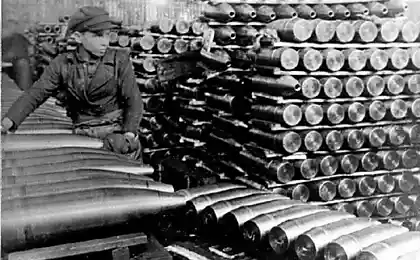1152
Moscow 1941
Writes samsebeskazal:
Favorite places and photos from the book "Taking off Russian war" Margaret Bourke-White, that summer of 1941 was the only foreign photographer in the Soviet Union. Her book is a unique material consisting of rare photographs, descriptions of events through the eyes of Western man and interesting household details. This post is a continuation. The first part consisted entirely of photos with captions. In this, I decided to add something that seemed interesting in the text. But it turned out a lot of letters that for readability I had to dilute their photos from the archives of LIFE. They also authored Bourke-White, but has long been the network, so the more known. I must clarify that this is not a literal translation of the text, and arbitrary attempt to retell the content of some chapters without distorting the facts specified therein. The book was published in New York in 1942. I have not bought the original edition ebay.
In the Soviet Union, Margaret went with her husband, writer and journalist Erskine Caldwell. Their union was short-lived. They married in 1939 and divorced in 1942. The trip does not publicized and consistent, and all that she was able to get permission of the State Department and US entry visa to the USSR. The representative of the Soviet embassy had warned her that for several years in the Soviet Union ban on the work of foreign photographers, and it can not guarantee that it will get permission to take photographs. One of the few who knew about the trip, Margaret, was the photo editor of the magazine LIFE. Her husband Erskine went as a freelancer. He had a preliminary agreement with LIFE magazine and CBS on the publication of the materials of the future, if such and will be of interest. The Soviet Union was chosen as a country that was soon to enter the war against Germany. In America, this has no doubt. The question was when this happened.
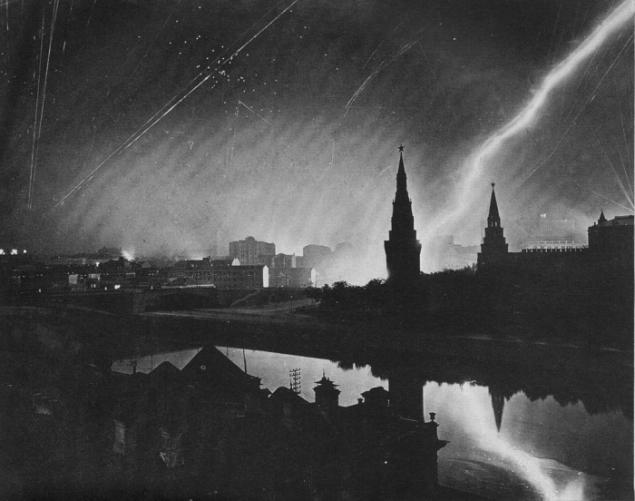
Margaret spent almost a month before the trip to prepare equipment and lessons on repair of photographic technique, realizing that something happened with technology in the Soviet Union, it would be with this problem alone. Since she took a 3000 flash lamps, a huge number of films, five cameras, twenty-two of the lens, portable equipment for printing and developing, photochemistry, duplicates of all screws used in the equipment and much more. A large part of it was sent to the sea in Hong Kong. All of this weighed about 300 kilograms. In late March 1941, they embarked on their long way: New York - Indianapolis - Honolulu - Midway Island - Wake Island - Manila - Hong Kong -Chuntsin - Lanzhou - Gobi - Hami - Almaty - Moscow. The journey was long, with stops and change of transport. Where they might traveled aircraft. Where there was no such possibility of traveling by car. In China alone have gone for a month. In Soviet customs in Alma-Ata have carefully inspected the equipment, check the contents of the bottles with the help of sticks. Suddenly there is hidden. What followed was a long flight to Moscow with multiple landings that took them one and a half days. In the capital of the USSR, they arrived at the beginning of May.
2. Gorky Street in the direction of the Historical Museum.
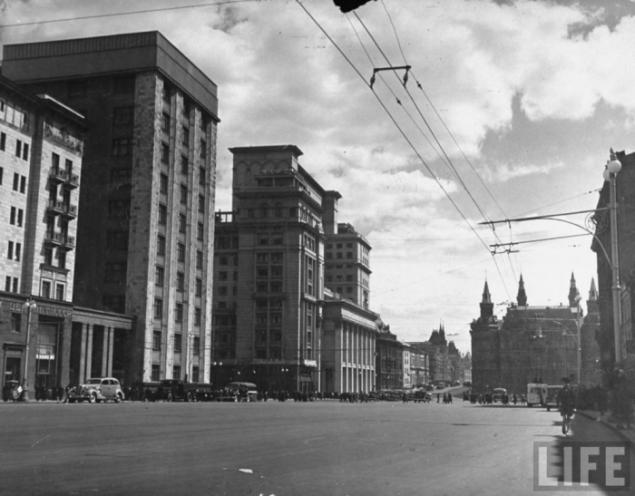
With three previous visits to the Soviet Union and with the help of the Writers' Union and the Society for cultural exchange with foreign countries, she managed to get permission to take photographs. Despite a bunch of prohibitions and restrictions imposed, it was still very happy. In addition to the prohibitions shooting hampered by bad weather. In May 1941 in Moscow, it was snowing and the sky is almost the whole month was covered with gray clouds. In addition to the clouds in the sky hung a premonition of a future war. When that act was non-aggression pact, the Germans were to be found in all the hotels in Moscow, and the Soviet press did not write any anti-German word in everyday conversations and moods interlocutors felt the imminent and inevitable war.
3. People listen to a speech in the Park of Culture and Recreation.
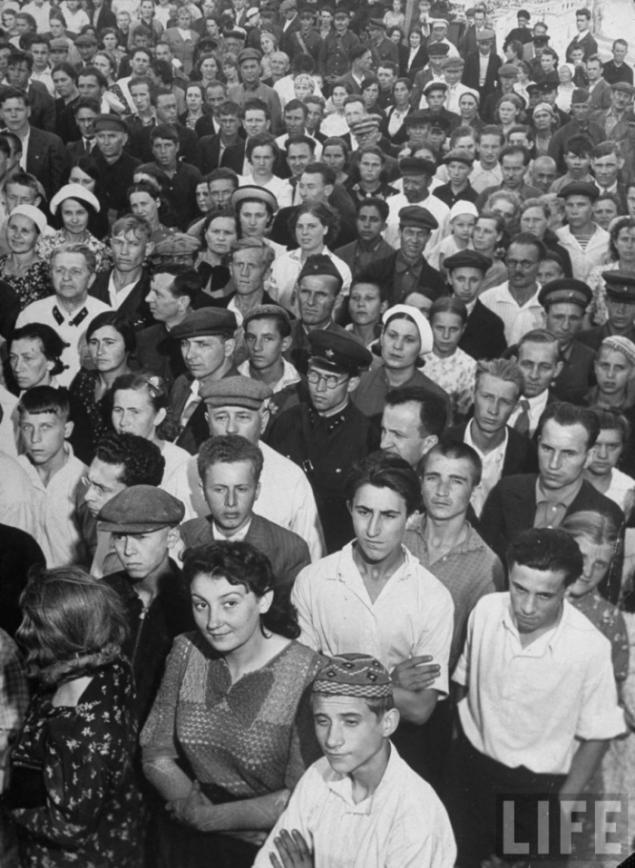
In Moscow they met Yevgeny Petrov, with whom Margaret had met in New York during his joint Ilf travel America (Ilf died in 1937). Sergei Eisenstein arranged for them a special screening of his film "Alexander Nevsky". After the session Eisenstein astutely noticed that very soon the film will return to the big screen.
4. Employees of the Mikoyan meat processing plant.
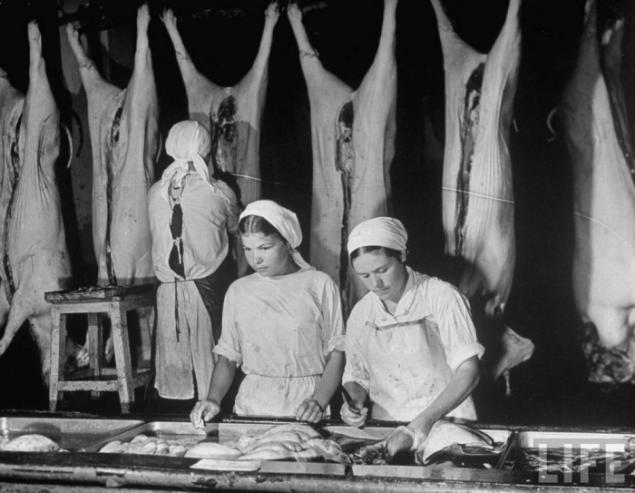
Most Margaret shook the news that in his speech on May 5, 1941 addressed to graduates of military academies, Stalin declared that Germany is the real enemy of the USSR. The text of the newspaper came as drafted, but the essence is still reached the Western journalists in Moscow. Send this news in the wording did not allow censorship. One of the correspondents who was able to secretly send the information about it abroad, was expelled from the Soviet Union during the week.
5. Turn the mausoleum.
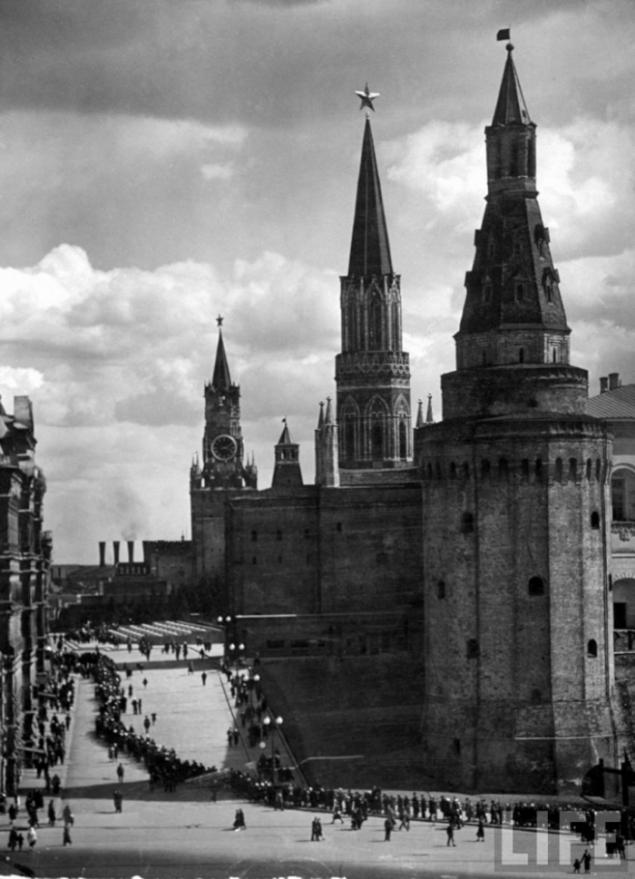
US Ambassador Steinhardt in a few weeks led to the preparation of a future evacuation of the diplomatic mission. Backing the US embassy was equipped in the country, 30 kilometers from Moscow to Leningrad Highway. He was completely absorbed in this question and chose the colors for painting the walls and a thick cloth to curtain windows. Fabrics, like many others, that it was impossible to get in Moscow, brought from Stockholm by special courier. He ordered the US several large tents and set them under the trees next to the house to accommodate the American citizens who will have to leave the hotel in the event of hostilities. Until the last moment he did not know that the place chosen by him for evacuation was dangerously close to a number of factories for the production of ammunition, have undergone massive bombings. When it became known that there was no opportunity and time to look for something else.
6. Turn in a clothing store on Gorky Street.
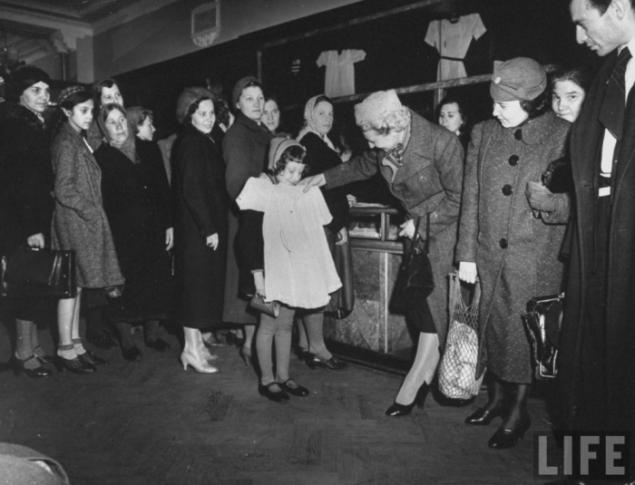
Margaret and her husband lived in a room at the National, which is almost half was inhabited by Germans. Room cost 96 rubles per day ($ 18 for the then existing rate). Room window faced the street Gorky - Fifth Avenue in Moscow, as she had her named. The windows could be seen cheese shop, shop sparkling wines, toy shop and was most impressed her store diet. Inside are a physician who is selected individually free diet and advice on healthy eating. Yet it struck dietary salads and 32 types of bread. She began to go there all the time because of the chocolate. In a typical grocery tiles cost $ 2.50 (if converted to dollars) in dietary same tiles specially made chocolate was worth only 50 cents.
7. Gorky Street.
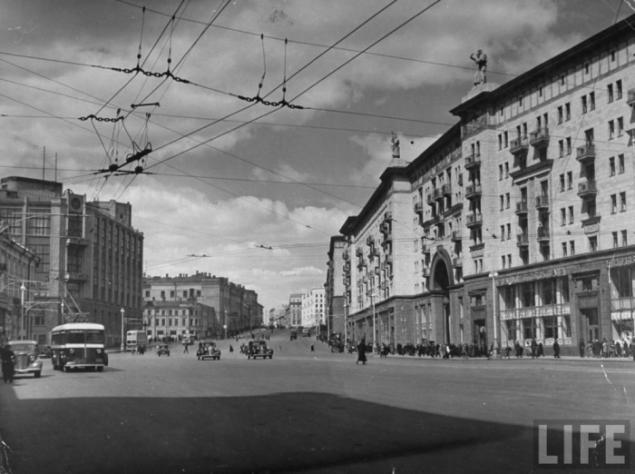
Margaret noticed that in normal conversation, people are increasingly turning to the subject of politics and war. It was walking a lot of jokes about Hitler. Here's one she heard in Moscow.
When he reached the shores of the English Channel, Hitler realized that before him irresistible water barrier, and he does not know what to do and how to translate the army on the other side. In search of a solution he refers to the old rabbi for advice:
- Tell me the rabbi, as I go through the channel?
- It is not difficult, he is responsible. Moses had the same problem a thousand years ago.
- And what did he do? asks Hitler.
- He did very simple. He took a stick, poked him in the water, and she parted in front of him.
- Oh! This is what I need. Where can I get this staff?
- At the British Museum, said the rabbi.
8. Moscow hotel lobby.
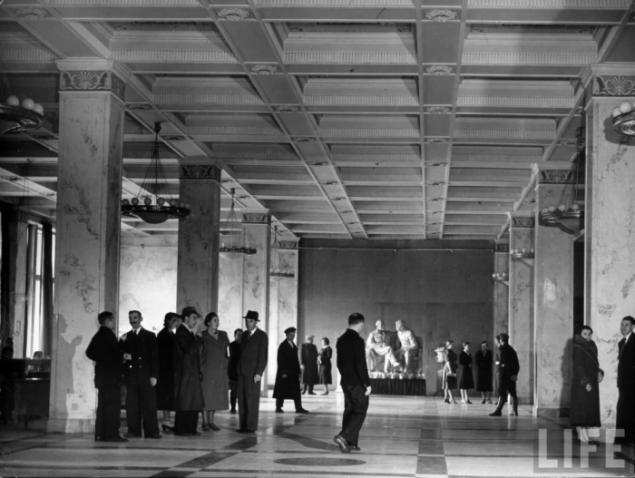
Another indicator of the deteriorating situation in the country was a ban on foreign travel outside of Moscow. Even diplomats had to obtain special permission to visit to the USSR. Many refuse. At first, it provoked outrage among diplomats, but then they realized that the measure is directed against the Germans, so that stay away from what is happening in the regions. In early June, Margaret and Erskine is possible to obtain permission for a short trip to the Soviet Union and, together with Yevgeny Petrov they go on a trip to the Ukraine, the Caucasus and the Crimea.
9. Kislovodsk.
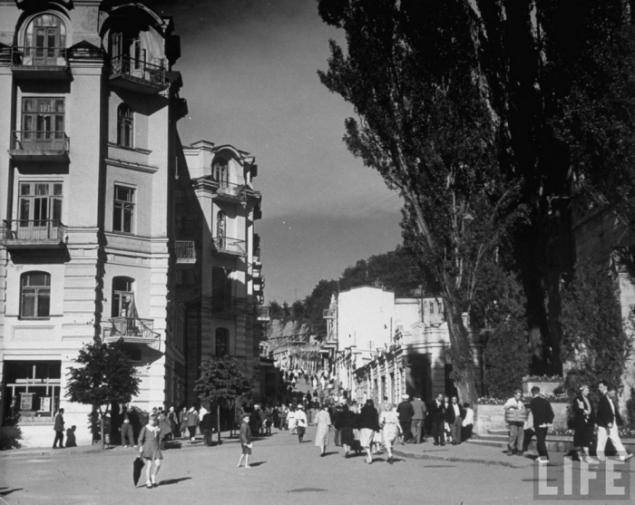
The news about the beginning of the war found their way back to when they travel by train from Sochi to Moscow. The overall picture of what is happening there. Until they reach only scraps of information from the radio stations and news that people pass from mouth to mouth. Along the way they encounter a lot of trains with soldiers and military equipment. One of the soldiers gives them through the window of the newspaper and read to her before the hole, transferring from car to car. In Moscow, they return only 27 of June and take up residence in the same Nazionale. They are given a room in which he lived until recently a sales representative in Germany in the Soviet Union. This is a huge apartment with a piano and a private terrace, which overlooks the Red Square and Lenin's mausoleum. The most amazing thing is that it is the same 96 rubles a day. Margaret questioned the porter and learned that the Germans began to massively leave the hotel a week before the war began. During this time, all German representatives promptly left Moscow. By Saturday, June 21 there was no one except two people who fled in a hurry the next morning, leaving their bags and not paying for accommodation.
10. The gates of the Kremlin.

The next morning, the first thing Margaret learns, it was a new order (she calls him «anticamera law»), based on which in each person with a camera in hand, you can shoot without warning. At this point, she realizes that she dropped the greatest chance in her life. She is the only photographer and a representative of the foreign press in a huge country, which became one of the greatest warrior in history. The second problem is the US ordered the mandatory evacuation of US citizens from Moscow. Some planes are taken in Stockholm, and the rest is sent by train to Vladivostok. Ambassador Steinhardt warns them as soon as possible bombardment of the city and said that the last two remaining vacant seats in the car, and it was their last chance to hoot. Margaret and her husband and refused to meet him come to Moscow to work and not to escape in one of the most important moments in history.
11. Moscow in the light of the moon.
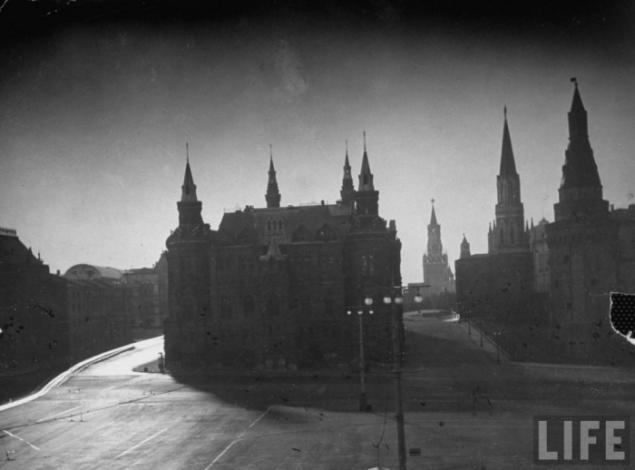
Evacuation of children are not officially declared, even when the front came to Smolensk. Instead, it was said that 20,000 students will be sent to the summer holidays in the northern areas "for research", and another 50,000 will go on an expedition to Central Asia "for geological investigations." When the Germans came closer to Moscow, the streets around the station were filled with thousands of women with children, who actually lived there long hours day in anticipation of free space on the train.
12. Street trade.
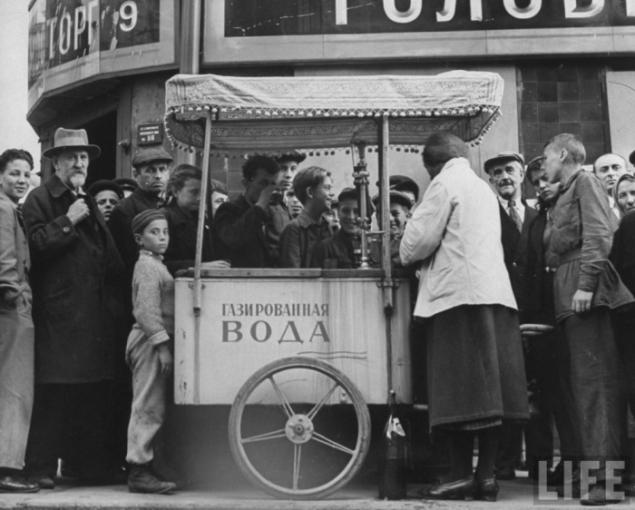
When Margaret went to the barber shop to wash your hair and nails done, then I saw the announcement that Moscow is no longer manicurist and this service is not available. To the question: Why? - She received the answer that all workers sent to the rear for the care of children. Margaret had the most to learn to paint and polish my nails.
13. Camouflage supported on Manezh Square.

14. Crowds of Muscovites go to the street from the metro station Sverdlov Square, where they hid during the next air raid. The building in the photo is the Hotel Moscow.

US Ambassador to the escort of six employees of the NKVD, who were both of his bodyguards and officers (Margaret called them YMCA boys). His every move was under control, wherever he went. The same fate befell the other diplomats. I have only the number of the oversight staff, which depended on the status of the accompanying person. Ambassador almost no contact with them, but he admitted that two years was so used to the silent companions, when they were not around, then began to miss them. She remembered the time when, during a dinner in one of the best and most expensive restaurants in Moscow, the people at the next table without objection and as a team got up and left, leaving a plate of half-eaten food. And all this only because it was necessary to put the ambassador accompanied the NKVD, who immediately ordered a most exquisite and expensive meals. Who pays for it all, and pay it at all, so it remained unknown. When the ambassador came to see him at the hotel, the two remained outside to guard the car, one is standing at the entrance to the hotel, one looked for the stairs and a lift to their floor, and the two stood in the hallway at the door of the room. NKVD did not hinder the movement of the city, and when they are one with the ambassador went down into the subway, you are helping them and far from the hustle and crowds.
15. An escalator in the metro, which raises the people upstairs at a speed three times faster than in New York.
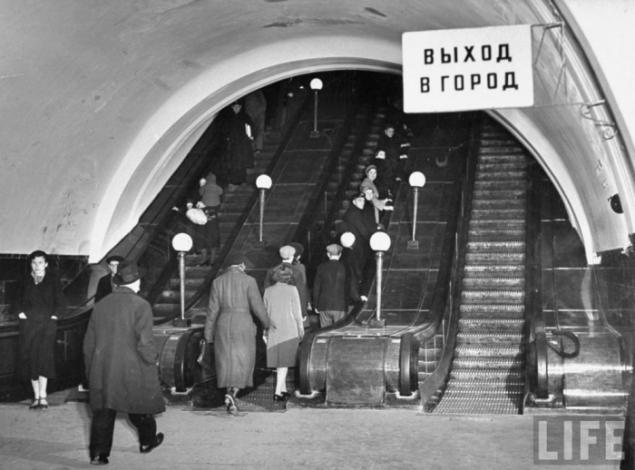
16. Mayakovskaya metro station.

The first bombing with a camera at the ready, Margaret met July 26 in Spazzo House, the residence of the US ambassador, which was used at the time as an embassy. It was the only place where she was sure that no one disturbed her during the attack and can not prohibit to shoot. That night Ambassador Steinhardt went to the cottage, and the building were only a few government workers who followed the roof and had to put out incendiary bombs. It started at ten o'clock in the evening. Margaret and her husband got to the sloping roof outside the ambassador's office and began to observe the sky, jagged dozens of powerful beams of searchlights. Above their heads, and there, there arose the outbreak of exploding shells, traces of tracer bullets and incendiary bombs bright flame, slowly descend by parachute. In the same night he was shot down the first German plane, and one of the 500-kilogram bombs exploded near Spazzo house fell on the theater building Vakhtangov and completely destroying it. The explosion killed people were in the shelter of the theater, as well as actors Vasily Cuza and Nikolai Chistyakov, who were on duty that night on the roof. Building residence escaped with only broken windows. Back at the hotel, Margaret began to show and print the resulting pictures, but the process was interrupted by the sound and touch of another air raid. To save the images she had to stay in the room and hide under the bed from the watchful attendants who checked the rooms and hotel guests were driven to the nearest bomb shelter.
17. People in the shelter.
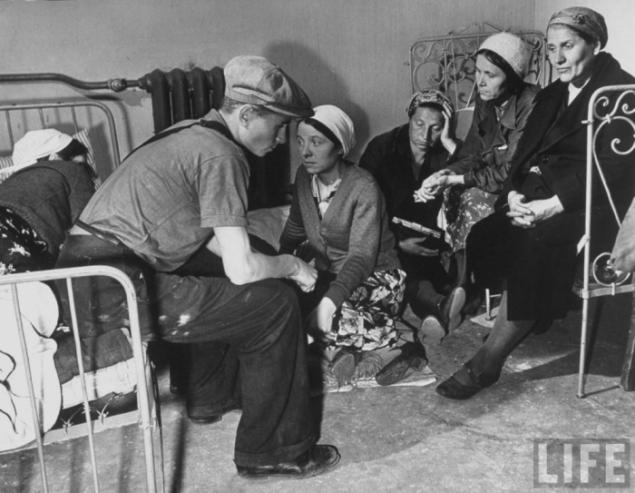
18. Ukrainian collective farmers. When the war began, the women willingly undertook the work that used to lay on the shoulders of men. We have to work three times as much, they told me. One time for themselves once in the men went to the front and once for our homeland. Morale was so strong that women no longer go to work, they marched at her. They have even begun to keep their farming tools as real weapons. Due to this they alone managed to harvest as effectively as if they were close to their sons and husbands.
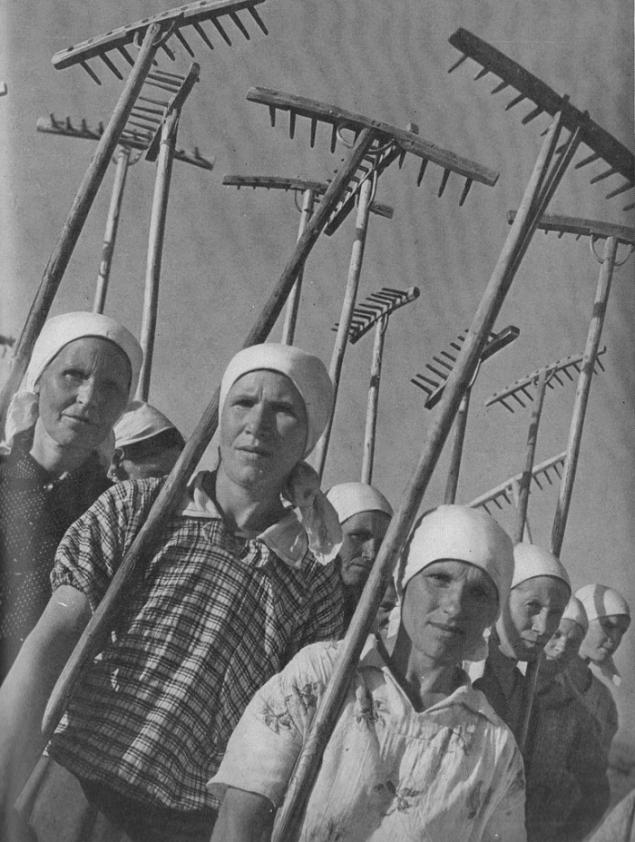
19. Factory posters. When I saw this scene, I thought that he was in the studio of Walt Disney. Artists, writers and poets worked together. In the photo on the right, they show a new series of posters with the letters of the alphabet, publishing one new letter every day. On the left you can see the cookie cutter copies of works by Ivan Timida. Posters were made using a stencil, pencil and gouache. The work was in full swing 24 hours a day.
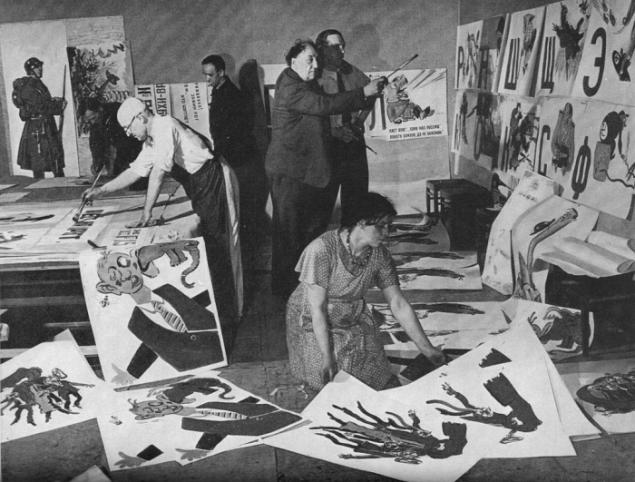
20. Since the Russian letters G and H in foreign names sound the same, they use it in their propaganda. Handsome as Goebbels. Slim as Goering. Blond, like Hitler.
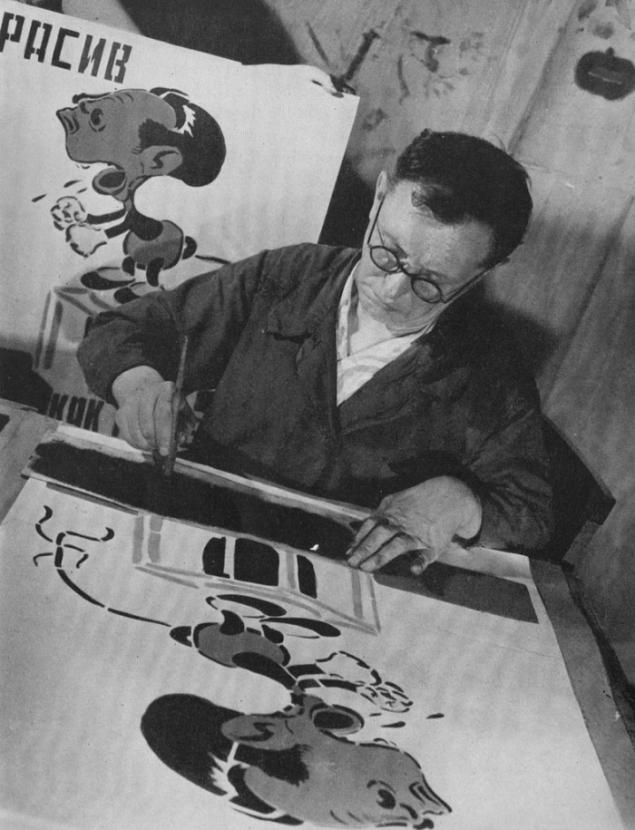
21. Posters in the health food store on Gorky Street.
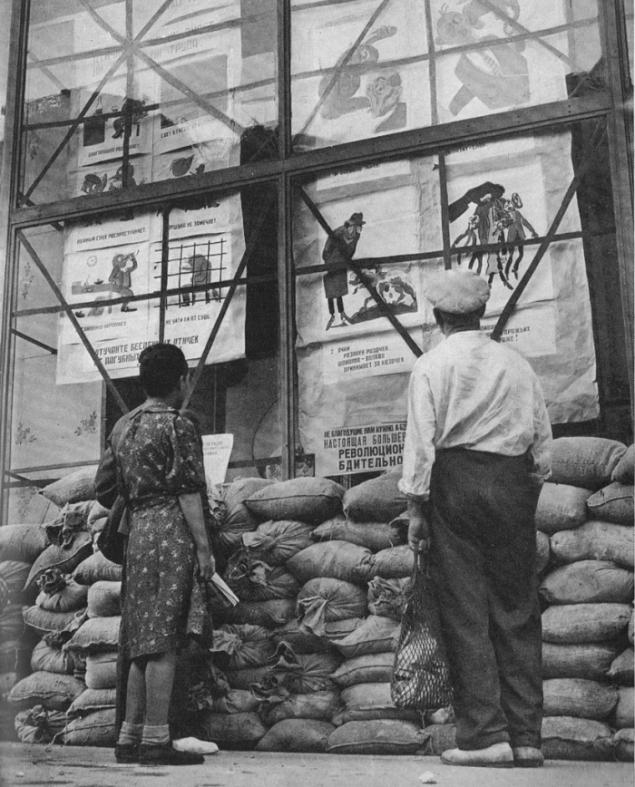
22. Orlov, Russian movie star and her husband, film director Alexander. Without any doubt, Lyubov Orlova most famous actress in the USSR and one of the few women in the country who wear slacks. It is so popular that when Alexander wants to go somewhere where a lot of soldiers and guards, then take it with you. No one is blocking their way, asks documents, and the soldiers just a friendly wave their hands and say they do not need a passport Orlova. She knows everything. She tomboy and loves jargon, what is trying to teach me. It is a universal favorite, and her husband adores it removes all the films exclusively with her participation.
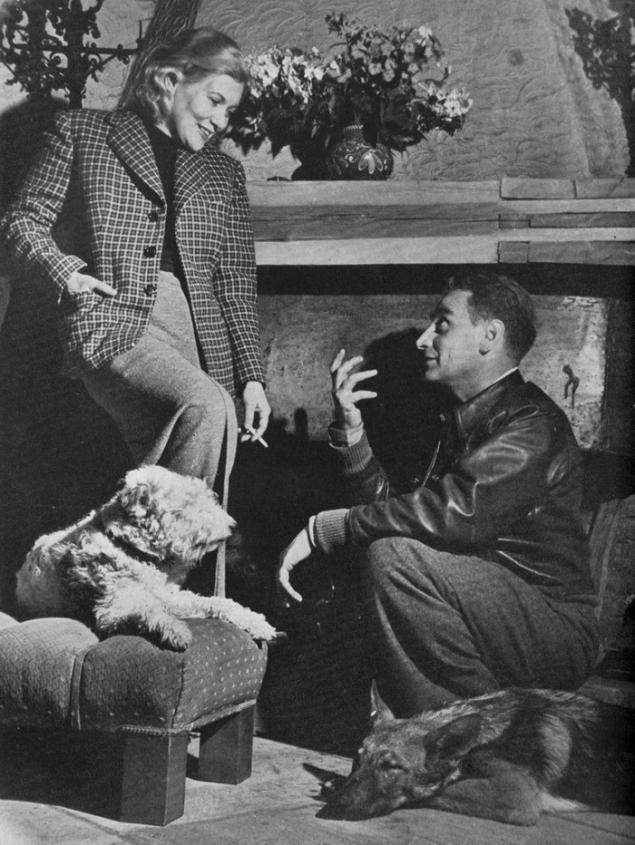
23. Alexandrov and Orlov greeted guests at his country house, which is located 40 kilometers from Moscow in the direction of Smolensk. Alexander himself designed the house, bringing architectural ideas from California and Mexico, where he worked on the film with Eisenstein. From the veranda you can watch the air raids on Moscow and the road towards the garden crammed military equipment and soldiers going in the direction of the front.
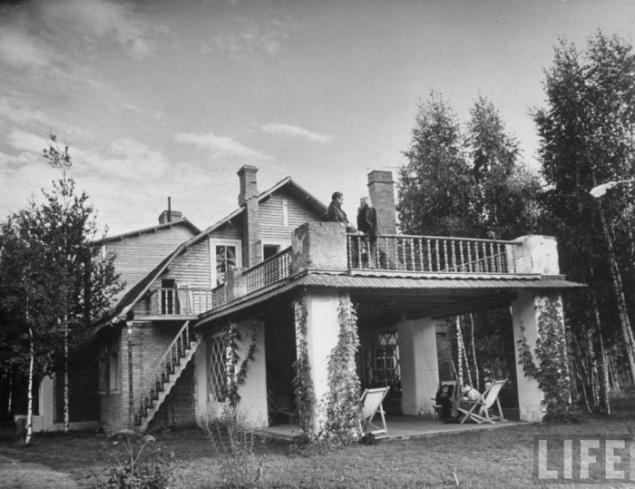
24. They have a large living room and a fireplace, which is very rare in Russia. Alexandrov calls his wife Charlie since they first met at one of the survey sites. Instead of the usual in such a situation (in America) cocktails served white and red wine.

©
Favorite places and photos from the book "Taking off Russian war" Margaret Bourke-White, that summer of 1941 was the only foreign photographer in the Soviet Union. Her book is a unique material consisting of rare photographs, descriptions of events through the eyes of Western man and interesting household details. This post is a continuation. The first part consisted entirely of photos with captions. In this, I decided to add something that seemed interesting in the text. But it turned out a lot of letters that for readability I had to dilute their photos from the archives of LIFE. They also authored Bourke-White, but has long been the network, so the more known. I must clarify that this is not a literal translation of the text, and arbitrary attempt to retell the content of some chapters without distorting the facts specified therein. The book was published in New York in 1942. I have not bought the original edition ebay.
In the Soviet Union, Margaret went with her husband, writer and journalist Erskine Caldwell. Their union was short-lived. They married in 1939 and divorced in 1942. The trip does not publicized and consistent, and all that she was able to get permission of the State Department and US entry visa to the USSR. The representative of the Soviet embassy had warned her that for several years in the Soviet Union ban on the work of foreign photographers, and it can not guarantee that it will get permission to take photographs. One of the few who knew about the trip, Margaret, was the photo editor of the magazine LIFE. Her husband Erskine went as a freelancer. He had a preliminary agreement with LIFE magazine and CBS on the publication of the materials of the future, if such and will be of interest. The Soviet Union was chosen as a country that was soon to enter the war against Germany. In America, this has no doubt. The question was when this happened.

Margaret spent almost a month before the trip to prepare equipment and lessons on repair of photographic technique, realizing that something happened with technology in the Soviet Union, it would be with this problem alone. Since she took a 3000 flash lamps, a huge number of films, five cameras, twenty-two of the lens, portable equipment for printing and developing, photochemistry, duplicates of all screws used in the equipment and much more. A large part of it was sent to the sea in Hong Kong. All of this weighed about 300 kilograms. In late March 1941, they embarked on their long way: New York - Indianapolis - Honolulu - Midway Island - Wake Island - Manila - Hong Kong -Chuntsin - Lanzhou - Gobi - Hami - Almaty - Moscow. The journey was long, with stops and change of transport. Where they might traveled aircraft. Where there was no such possibility of traveling by car. In China alone have gone for a month. In Soviet customs in Alma-Ata have carefully inspected the equipment, check the contents of the bottles with the help of sticks. Suddenly there is hidden. What followed was a long flight to Moscow with multiple landings that took them one and a half days. In the capital of the USSR, they arrived at the beginning of May.
2. Gorky Street in the direction of the Historical Museum.

With three previous visits to the Soviet Union and with the help of the Writers' Union and the Society for cultural exchange with foreign countries, she managed to get permission to take photographs. Despite a bunch of prohibitions and restrictions imposed, it was still very happy. In addition to the prohibitions shooting hampered by bad weather. In May 1941 in Moscow, it was snowing and the sky is almost the whole month was covered with gray clouds. In addition to the clouds in the sky hung a premonition of a future war. When that act was non-aggression pact, the Germans were to be found in all the hotels in Moscow, and the Soviet press did not write any anti-German word in everyday conversations and moods interlocutors felt the imminent and inevitable war.
3. People listen to a speech in the Park of Culture and Recreation.

In Moscow they met Yevgeny Petrov, with whom Margaret had met in New York during his joint Ilf travel America (Ilf died in 1937). Sergei Eisenstein arranged for them a special screening of his film "Alexander Nevsky". After the session Eisenstein astutely noticed that very soon the film will return to the big screen.
4. Employees of the Mikoyan meat processing plant.

Most Margaret shook the news that in his speech on May 5, 1941 addressed to graduates of military academies, Stalin declared that Germany is the real enemy of the USSR. The text of the newspaper came as drafted, but the essence is still reached the Western journalists in Moscow. Send this news in the wording did not allow censorship. One of the correspondents who was able to secretly send the information about it abroad, was expelled from the Soviet Union during the week.
5. Turn the mausoleum.

US Ambassador Steinhardt in a few weeks led to the preparation of a future evacuation of the diplomatic mission. Backing the US embassy was equipped in the country, 30 kilometers from Moscow to Leningrad Highway. He was completely absorbed in this question and chose the colors for painting the walls and a thick cloth to curtain windows. Fabrics, like many others, that it was impossible to get in Moscow, brought from Stockholm by special courier. He ordered the US several large tents and set them under the trees next to the house to accommodate the American citizens who will have to leave the hotel in the event of hostilities. Until the last moment he did not know that the place chosen by him for evacuation was dangerously close to a number of factories for the production of ammunition, have undergone massive bombings. When it became known that there was no opportunity and time to look for something else.
6. Turn in a clothing store on Gorky Street.

Margaret and her husband lived in a room at the National, which is almost half was inhabited by Germans. Room cost 96 rubles per day ($ 18 for the then existing rate). Room window faced the street Gorky - Fifth Avenue in Moscow, as she had her named. The windows could be seen cheese shop, shop sparkling wines, toy shop and was most impressed her store diet. Inside are a physician who is selected individually free diet and advice on healthy eating. Yet it struck dietary salads and 32 types of bread. She began to go there all the time because of the chocolate. In a typical grocery tiles cost $ 2.50 (if converted to dollars) in dietary same tiles specially made chocolate was worth only 50 cents.
7. Gorky Street.

Margaret noticed that in normal conversation, people are increasingly turning to the subject of politics and war. It was walking a lot of jokes about Hitler. Here's one she heard in Moscow.
When he reached the shores of the English Channel, Hitler realized that before him irresistible water barrier, and he does not know what to do and how to translate the army on the other side. In search of a solution he refers to the old rabbi for advice:
- Tell me the rabbi, as I go through the channel?
- It is not difficult, he is responsible. Moses had the same problem a thousand years ago.
- And what did he do? asks Hitler.
- He did very simple. He took a stick, poked him in the water, and she parted in front of him.
- Oh! This is what I need. Where can I get this staff?
- At the British Museum, said the rabbi.
8. Moscow hotel lobby.

Another indicator of the deteriorating situation in the country was a ban on foreign travel outside of Moscow. Even diplomats had to obtain special permission to visit to the USSR. Many refuse. At first, it provoked outrage among diplomats, but then they realized that the measure is directed against the Germans, so that stay away from what is happening in the regions. In early June, Margaret and Erskine is possible to obtain permission for a short trip to the Soviet Union and, together with Yevgeny Petrov they go on a trip to the Ukraine, the Caucasus and the Crimea.
9. Kislovodsk.

The news about the beginning of the war found their way back to when they travel by train from Sochi to Moscow. The overall picture of what is happening there. Until they reach only scraps of information from the radio stations and news that people pass from mouth to mouth. Along the way they encounter a lot of trains with soldiers and military equipment. One of the soldiers gives them through the window of the newspaper and read to her before the hole, transferring from car to car. In Moscow, they return only 27 of June and take up residence in the same Nazionale. They are given a room in which he lived until recently a sales representative in Germany in the Soviet Union. This is a huge apartment with a piano and a private terrace, which overlooks the Red Square and Lenin's mausoleum. The most amazing thing is that it is the same 96 rubles a day. Margaret questioned the porter and learned that the Germans began to massively leave the hotel a week before the war began. During this time, all German representatives promptly left Moscow. By Saturday, June 21 there was no one except two people who fled in a hurry the next morning, leaving their bags and not paying for accommodation.
10. The gates of the Kremlin.

The next morning, the first thing Margaret learns, it was a new order (she calls him «anticamera law»), based on which in each person with a camera in hand, you can shoot without warning. At this point, she realizes that she dropped the greatest chance in her life. She is the only photographer and a representative of the foreign press in a huge country, which became one of the greatest warrior in history. The second problem is the US ordered the mandatory evacuation of US citizens from Moscow. Some planes are taken in Stockholm, and the rest is sent by train to Vladivostok. Ambassador Steinhardt warns them as soon as possible bombardment of the city and said that the last two remaining vacant seats in the car, and it was their last chance to hoot. Margaret and her husband and refused to meet him come to Moscow to work and not to escape in one of the most important moments in history.
11. Moscow in the light of the moon.

Evacuation of children are not officially declared, even when the front came to Smolensk. Instead, it was said that 20,000 students will be sent to the summer holidays in the northern areas "for research", and another 50,000 will go on an expedition to Central Asia "for geological investigations." When the Germans came closer to Moscow, the streets around the station were filled with thousands of women with children, who actually lived there long hours day in anticipation of free space on the train.
12. Street trade.

When Margaret went to the barber shop to wash your hair and nails done, then I saw the announcement that Moscow is no longer manicurist and this service is not available. To the question: Why? - She received the answer that all workers sent to the rear for the care of children. Margaret had the most to learn to paint and polish my nails.
13. Camouflage supported on Manezh Square.

14. Crowds of Muscovites go to the street from the metro station Sverdlov Square, where they hid during the next air raid. The building in the photo is the Hotel Moscow.

US Ambassador to the escort of six employees of the NKVD, who were both of his bodyguards and officers (Margaret called them YMCA boys). His every move was under control, wherever he went. The same fate befell the other diplomats. I have only the number of the oversight staff, which depended on the status of the accompanying person. Ambassador almost no contact with them, but he admitted that two years was so used to the silent companions, when they were not around, then began to miss them. She remembered the time when, during a dinner in one of the best and most expensive restaurants in Moscow, the people at the next table without objection and as a team got up and left, leaving a plate of half-eaten food. And all this only because it was necessary to put the ambassador accompanied the NKVD, who immediately ordered a most exquisite and expensive meals. Who pays for it all, and pay it at all, so it remained unknown. When the ambassador came to see him at the hotel, the two remained outside to guard the car, one is standing at the entrance to the hotel, one looked for the stairs and a lift to their floor, and the two stood in the hallway at the door of the room. NKVD did not hinder the movement of the city, and when they are one with the ambassador went down into the subway, you are helping them and far from the hustle and crowds.
15. An escalator in the metro, which raises the people upstairs at a speed three times faster than in New York.

16. Mayakovskaya metro station.

The first bombing with a camera at the ready, Margaret met July 26 in Spazzo House, the residence of the US ambassador, which was used at the time as an embassy. It was the only place where she was sure that no one disturbed her during the attack and can not prohibit to shoot. That night Ambassador Steinhardt went to the cottage, and the building were only a few government workers who followed the roof and had to put out incendiary bombs. It started at ten o'clock in the evening. Margaret and her husband got to the sloping roof outside the ambassador's office and began to observe the sky, jagged dozens of powerful beams of searchlights. Above their heads, and there, there arose the outbreak of exploding shells, traces of tracer bullets and incendiary bombs bright flame, slowly descend by parachute. In the same night he was shot down the first German plane, and one of the 500-kilogram bombs exploded near Spazzo house fell on the theater building Vakhtangov and completely destroying it. The explosion killed people were in the shelter of the theater, as well as actors Vasily Cuza and Nikolai Chistyakov, who were on duty that night on the roof. Building residence escaped with only broken windows. Back at the hotel, Margaret began to show and print the resulting pictures, but the process was interrupted by the sound and touch of another air raid. To save the images she had to stay in the room and hide under the bed from the watchful attendants who checked the rooms and hotel guests were driven to the nearest bomb shelter.
17. People in the shelter.

18. Ukrainian collective farmers. When the war began, the women willingly undertook the work that used to lay on the shoulders of men. We have to work three times as much, they told me. One time for themselves once in the men went to the front and once for our homeland. Morale was so strong that women no longer go to work, they marched at her. They have even begun to keep their farming tools as real weapons. Due to this they alone managed to harvest as effectively as if they were close to their sons and husbands.

19. Factory posters. When I saw this scene, I thought that he was in the studio of Walt Disney. Artists, writers and poets worked together. In the photo on the right, they show a new series of posters with the letters of the alphabet, publishing one new letter every day. On the left you can see the cookie cutter copies of works by Ivan Timida. Posters were made using a stencil, pencil and gouache. The work was in full swing 24 hours a day.

20. Since the Russian letters G and H in foreign names sound the same, they use it in their propaganda. Handsome as Goebbels. Slim as Goering. Blond, like Hitler.

21. Posters in the health food store on Gorky Street.

22. Orlov, Russian movie star and her husband, film director Alexander. Without any doubt, Lyubov Orlova most famous actress in the USSR and one of the few women in the country who wear slacks. It is so popular that when Alexander wants to go somewhere where a lot of soldiers and guards, then take it with you. No one is blocking their way, asks documents, and the soldiers just a friendly wave their hands and say they do not need a passport Orlova. She knows everything. She tomboy and loves jargon, what is trying to teach me. It is a universal favorite, and her husband adores it removes all the films exclusively with her participation.

23. Alexandrov and Orlov greeted guests at his country house, which is located 40 kilometers from Moscow in the direction of Smolensk. Alexander himself designed the house, bringing architectural ideas from California and Mexico, where he worked on the film with Eisenstein. From the veranda you can watch the air raids on Moscow and the road towards the garden crammed military equipment and soldiers going in the direction of the front.

24. They have a large living room and a fireplace, which is very rare in Russia. Alexandrov calls his wife Charlie since they first met at one of the survey sites. Instead of the usual in such a situation (in America) cocktails served white and red wine.

©
